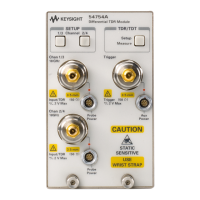TDR Fundamentals
Propagation on a Transmission Line
9-5
The velocity at which the voltage travels down the line can be defined in terms
of β where:
The velocity of propagation approaches the speed of light, v
c
, for transmission
lines with air dielectric. For the general case where ε
r
is the dielectric constant.
The propagation constant γ can be used to define the voltage and the current
at any distance x down an infinitely long line by the relations
Since the voltage and the current are related at any point by the characteristic
impedance of the line
When the transmission line is finite in length and is terminated in a load whose
impedance matches the characteristic impedance of the line, the voltage and
current relationships are satisfied by the preceding equations.
If the load is different from Z
o
, these equations are not satisfied unless a second
wave is considered to originate at the load and to propagate back up the line
toward the source. This reflected wave is energy that is not delivered to the
load. Therefore, the quality of the transmission system is indicated by the ratio
of this reflected wave to the incident wave originating at the source. This ratio
is called the voltage reflection coefficient, ρ, and is related to the transmission
line impedance by the equation:
The magnitude of the steady-state sinusoidal voltage along a line terminated in
a load other than Z
o
varies periodically as a function of distance between a
maximum and minimum value. This variation called a standing wave, is caused
v
p
ω
β
----
unit length per second=
v
p
v
c
ε
r
--------=
E
x
E
in
e
ϒ
x
–
=
I
x
I
in
e
ϒ
x
–
=
Z
o
E
in
e
ϒ
x
–
I
in
e
ϒ
x
–
------------------
E
in
I
in
------- Z
in
===
ρ
E
r
E
i
-----
Z
L
Z
o
–
Z
L
Z
o
+
------------------==

